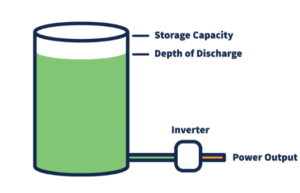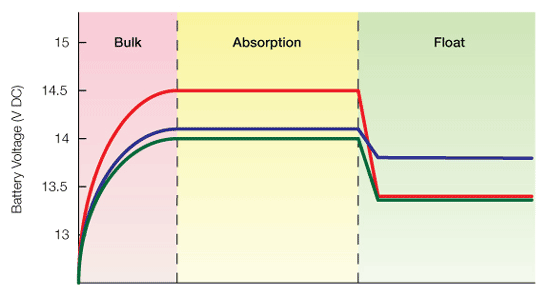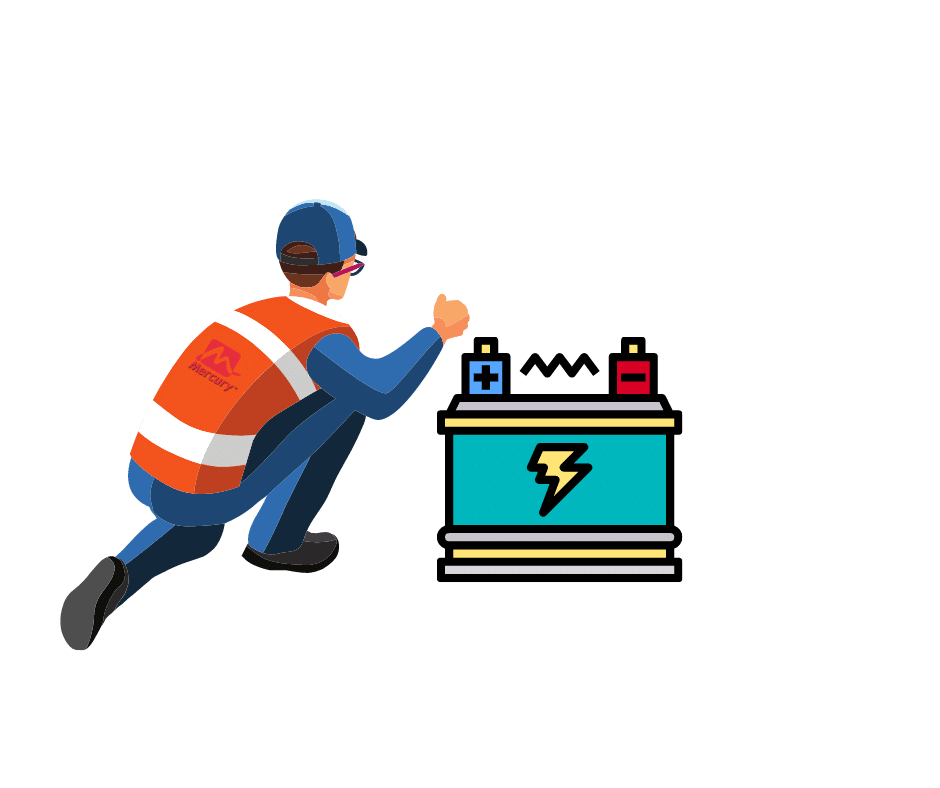At Mercury Direct, we get asked a lot about how long inverter batteries will last. The number of years an Inverter battery lasts is to a large extent determined by how well it is treated. Inverter batteries usually do not die naturally, but from misuse many years before their expiration date. In this article, we will show you 10 simple ways to extend the life of your inverter battery.

A battery’s depth of discharge (DoD) refers to how deeply it has been discharged. To ensure that your battery lasts as long as possible, make sure you don’t over-discharge it. If you fully discharge a battery only once, you can cause irreversible damage, and if you discharge it 100% frequently, you will shorten its lifespan. Thus, a 3 or 4-year battery may only last you one or two years.
A battery’s cycle life is the number of charges and discharges that it can complete before its performance starts to decline. An Inverter battery’s cycle life is affected by how deeply it is discharged. Although Tall Tubular and AGM deep cycle batteries are designed for deep discharge, they are not meant to be fully discharged.
If you only discharge your Tall Tubular and AGM deep cycle batteries to 50% before recharging them, you will significantly extend their lifespan. However, in countries like Nigeria, where the grid’s power is neither predictable nor reliable. Many people discharge their inverter batteries up to 80% out of necessity.
While regularly discharging a Tall Tubular or AGM deep cycle battery beyond 80% will significantly shorten its life. A lithium battery, on the other hand, can be depleted to 90% of its total capacity (10% SOC) without any repercussions.
The cost of a lithium battery is high, however, making AGM and Tall Tubular the options that give the highest return on investment. Regardless of the type of battery, you are using. When you hear your power inverter’s low battery alarm, turn it off. Do not allow your power inverter to shut off on its own.

As shown in the above chart, when an AGM battery (at an average temperature of 25 °C) reaches 80% depth of discharge, the battery provides approximately 400 cycles or just over 1.5 years (if cycled daily), and with 30% depth of discharge, the battery offers 1200 cycles.


Your inverter battery goes through cycles when you use it. You have completed a cycle when you have used 100 per cent of the battery’s capacity. Recharging your battery after discharging it to 50% is not considered a full cycle. Repeating the same action, however, counts as one cycle
Battery cycles can have a major impact on battery life. It is harmful to the battery’s longevity to keep it fully charged for extended periods without using it.
A fully depleted battery can also reduce its ability to hold a charge if you leave it sitting for a long time without charging. Performing regular battery cycles will extend the life of your battery.


Incorrect charging is a major cause of inverter battery failure. In the market, there are many batteries with different chemistry, as well as guidelines on how they should be handled and charged.
It can be fatal to use a charger not designed for your battery size and chemistry. Inverter battery chargers should charge batteries as reliably and effectively as possible. Whenever possible, use an inverter or charger from the same manufacturer as the batteries
While some chargers damage batteries as they charge them, others heal and repair them as they charge.There is a significant difference between a high-quality battery charger and a low-cost battery charger that, if used incorrectly, might destroy your battery.
The high-quality chargers are often three-stage and offer a variety of safety measures, such as not allowing electricity to flow until the battery is properly attached. They may also be fan-cooled and have features such as automated temperature adjustment, short circuit protection, and other similar functions.
The low-cost battery charger lacks the above-mentioned safety measures and does not automatically reduce the voltage after the bulk charge has been completed.
If this type of charger is left unattended, it is possible to do substantial harm to your battery, possibly to the point of severe failure. Before charging your deep cycle batteries, make sure you’ve read the instructions and have taken all necessary measures. By measuring the voltage on a regular basis, you may obtain a decent indication of your batteries’ state of charge


When two or more batteries are connected in series, installing a battery equalizer system is an inexpensive way to extend the life of your batteries. Battery equalizers are easy to install and maintain, so they are an excellent investment for inverter batteries.
In order to equalize the voltage of the battery system, a battery equalizer system transfers energy between connected batteries. The system can compensate for both batteries when there is a voltage difference of more than 10 mV
AGM, Tubular and Lithium batteries can all benefit from battery equalizers because they can maintain a state of equilibrium for extended periods of time.
You should not use a battery equalizer with deep-cycle GEL batteries. Equilibrating GEL batteries will cause permanent damage.
Temperature greatly affects the life of a battery. Temperature swings affect all batteries, no matter what type they are, tall tubular, AGM, GEL or lithium battery. Generally, inverter batteries should be charged and maintained between 50-95 degrees Fahrenheit, or 10-35 degrees Celsius.
In order to maintain its life, a battery should not be exposed to extreme temperatures – hot or cold -. Battery life and efficiency are significantly reduced by extreme temperatures, which stress the battery.
According to Peukert’s law, when using lead-acid deep cycle batteries the faster the rate of discharge, the lower the capacity of the battery. A battery bank should be correctly sized for the load it is intended to carry. Using the incorrect size battery bank will result in performance problems.
Sulphation can result from draining your battery too quickly. Lead sulphate crystallizes on the cathode of a lead-acid battery, diminishing the conductive surface area and limiting the amount of current available, thereby depriving the battery of maximum power. Deposition of lead sulfate crystals is the main cause of lead-acid battery degradation and early death
Utilize energy-saving technologies to reduce the power you draw from your inverter batteries. A conventional bulb uses 75 per cent more energy than a CFL or LED. A ceiling fan with superior copper wire uses less energy than one with poor copper winding (poor copper winding increases resistance and increases the load on inverters).

Make sure your battery terminals are free of corrosion and rust which lowers the performance of your battery and reduces the current flow. As a result, battery life is lessened and backup times are shorter.
A solution of hot water and baking soda can be poured on the terminals of your battery to prevent rusting, and vaseline or petroleum jelly applied to prevent further corrosion.
For optimal performance and lifespan. Do not mix batteries of different ages, types or sizes. For example you should not mix flooded and sealed lead acid batteries because the charge profiles of both of these are slightly different.
Each battery contributes to the total voltage when batteries are connected in series. This voltage drops when one eventually fails, perhaps because of sulfation. You should change the entire battery bank, with new batteries. Individual batteries shouldn’t be replaced, since they would be out of balance with the older ones.
A new battery has a low resistance, which increases as it ages. Joule’s law states that thermal energy gain accompanies loss of electrical energy. In this way, when old and new batteries are mixed, too much energy passes through an abnormally high resistance. The new batteries run out sooner, while the old batteries overheat. We waste good money when we mix old and new.
Wet cell batteries need to be topped up regularly with Distilled water. You should never fill a battery with normal water. It will damage it and if you don’t top up at the appropriate time and with the proper amount, your battery’s performance and lifespan will suffer.
Distilled water should always be added after the battery has been completely charged. There should be enough water to cover the plates before charging. The water level should be above the plates if the battery has been depleted (partially or totally).
After a complete charge, keep the water level at the proper level to avoid having to worry about the water level in a different state of charge. We recommend checking batteries once a month until you get a sense of how often they need to be topped up.
- Safety Precautions:
- Always use insulated tools when working on batteries.
- Remove all rings, watches, bracelets, and other metal jewelry.
- Wear protective clothing at all times.
- Safeguard your eyes by wearing protective eyewear.
- When handling batteries, do not smoke or expose a naked flame.
- Make sure the places where batteries are stored or charged are adequately ventilated.
- If acid is spilled on skin or clothing – wash with plenty of clean water
- If acid comes into contact with eyes – wash with plenty of clean water and seek immediate medical attention
Ultimately, the key to extending the life of your inverter battery is to perform basic maintenance. The components listed above are clear and concise methods of prolonging the life of your battery, saving you time, money, and frustration in the long run.

